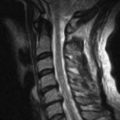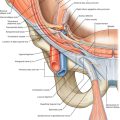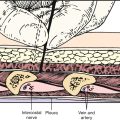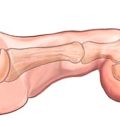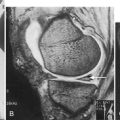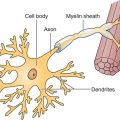CHAPTER 96
Chemotherapy-Induced Peripheral Neuropathy
Maryam R. Aghalar, DO; Christian M. Custodio, MD
Definition
Chemotherapy-induced peripheral neuropathy (CIPN) is damage and dysfunction of the peripheral nervous system secondary to chemotherapeutic agents, including platinum agents, taxanes, vinca alkaloids, thalidomide, bortezomib, and ixabepilone (Table 96.1). CIPN commonly occurs in 30% to 40% of patients, but its incidence can vary from 0% to 70% [1]. The degree of neuronal damage is dependent on many factors, such as the chemotherapeutic agent, the frequency and duration of therapy, the cumulative dose, the use of other neurotoxic agents, and the presence of preexisting neuropathies, most commonly from diabetes [1]. The severity of neuropathy generally increases until cessation of treatment. However, symptoms associated with platinum drugs may progress for weeks to months after treatment completion, a phenomenon called the “coasting” effect [2]. Many scales have been proposed to assess CIPN but lack standardization and reproducibility. The most widely used tool is the National Cancer Institute Common Terminology Criteria for Adverse Events (v4.03) (Table 96.2) [3]. Another scale is called the Total Neuropathy Score, which appears to be more sensitive in detecting changes in CIPN [4].
Table 96.1
Most Common Chemotherapeutic Agents Known to Induce Neuropathy
| Drug | Mechanism of Action |
| Platinum compounds (cisplatin, carboplatin, oxaliplatin) | Damages DNA in dorsal root ganglion, causing neuronopathy or ganglionopathy with sensory axonal neuropathy |
| Vinca alkaloids (vincristine, vinblastine, vinorelbine, vindesine) Taxanes (paclitaxel, paclitaxel albumin-stabilized nanoparticle formulation [Abraxane], docetaxel) |
Antimicrotubule agents that inhibit axonal transport, causing sensorimotor axonal neuropathy |
Table 96.2
National Cancer Institute Common Terminology Criteria for Adverse Events (v4.03), Motor and Sensory Combined
| Grade | Description | Action |
| 0 | Normal | No intervention |
| 1 | Asymptomatic, clinical or diagnostic observations only, weakness on examination only, loss of deep tendon reflexes or paresthesia | No intervention |
| 2 | Moderate symptoms, limiting instrumental activities of daily living | Decrease dosage |
| 3 | Severe symptoms, limiting self-care activities of daily living, assistive devices indicated | Decrease dosage or discontinue treatment |
| 4 | Life-threatening consequences, disabling | Discontinue treatment, urgent intervention indicated |
| 5 | Death |
Symptoms
The onset of symptoms can be sudden or slowly progress over time. Symptoms can vary by what types of nerve fibers are affected. Sensory nerves are more commonly affected first because they have small fibers, they have little capacity for regeneration, and their cell bodies are located in dorsal root ganglion, where they are outside the protective blood-brain barrier. The dorsal root ganglion has a high supply of capillaries that are highly permeable to toxic compounds in the blood [5]. Patients can present with symmetric, distal, length-dependent, “stocking-glove” distribution of painful paresthesia, dysesthesia, cold sensitivity, allodynia, tingling, and numbness. The patients also may report muscle cramps and pain described as burning, lancinating, shock-like, or electric. Motor nerve fiber cell bodies located in the spinal cord are less affected as they are protected within the blood-brain barrier and they also have the capacity for distal sprouting and regeneration. Patients usually present with muscle weakness, myalgias, and difficulty in walking. If autonomic nerves are affected, patients can present with orthostatic hypotension, constipation, urinary retention, irregular heart rate, and sexual dysfunction [6].
Physical Examination
Physical examination should assess for impairments with any sensory modalities, including light touch, pinprick, proprioception, and temperature. Deep tendon reflexes may be absent. Motor strength, gait, and balance deficits should also be evaluated in detail. Lhermitte sign, which is defined as eliciting an electric sensation running down the spine with neck flexion, may be present, especially after platinum compounds secondary to demyelination in the spinal cord [7].
Functional Limitations
The severity of the symptoms can range from mild discomfort and pain to severe disability and paralysis, with reduced functional independence and reduced quality of life. Weakness and proprioceptive impairments in the lower extremities may cause difficulty with mobility, balance, and gait, resulting in an increased risk of falls and injury. Weakness and sensory impairments in the upper extremities may cause difficulties with fine motor activities such as buttoning, tying shoelaces, cutting food, opening medication containers, typing on a computer keyboard, or operating a cell phone.
Diagnostic Studies
There is no standardized or “gold standard” diagnostic study to evaluate CIPN. Objective assessment such as nerve conduction studies, electromyography, and quantitative sensory testing can assess function and type of nerve damage (axonal vs demyelinating). These findings correlate poorly with the patient’s report of symptoms, and changes in these tests can lag behind the onset of symptoms [7]. Other diagnostic tests should be used to screen for other causes of neuropathy (complete blood count; erythrocyte sedimentation rate; C-reactive protein level; vitamin B12, methylmalonic acid, homocysteine, and folate concentrations; comprehensive metabolic panel to evaluate fasting blood glucose concentration; renal function and liver function tests; thyroid function tests; serum protein immunofixation electrophoresis; urinalysis and urine protein electrophoresis with immunofixation; drugs and toxin screen; paraneoplastic panel) [8]. Magnetic resonance imaging can also be done to rule out compression neuropathies and radiculopathy.
Treatment
Initial
The main treatment of CIPN is to discontinue the offending agent or to reduce the dosage or frequency of administration. However, altering the treatment regimen needs to be weighed against the overall efficacy in treating the underlying disease. Many agents have been studied for prevention of CIPN (such as vitamin E and glutamine) but need larger randomized placebo-controlled trials to be scientifically proven to be effective. Other agents, such as calcium and magnesium infusions, glutathione, and α-lipoic acid, are currently under clinical trial investigation. Aside from stopping or decreasing the dose of the chemotherapeutic agent, there are no agents specifically approved for treatment of CIPN. Many drugs are being used on the basis of their efficacy in reducing pain intensity for other types of neuropathic pain, such as diabetic neuropathy [9]. In particular, pregabalin [10] and duloxetine [11] have been shown in clinical trials to be efficacious in reducing the symptoms of CIPN. Other agents commonly used for neuropathy, which have not been scientifically proven to be efficacious for CIPN, include gabapentin, venlafaxine, tricyclic antidepressants (amitriptyline and nortriptyline), and opioids. Topical agents such as capsaicin and lidocaine patches have also been found to be effective in certain forms of peripheral neuropathy [12]. A more recent topical gel formula, BAK-PLO (baclofen, amitriptyline, and ketamine in pluronic lecithin organogel), has shown moderate improvement in CIPN pain symptoms [13]. Medications are usually helpful in relieving the positive symptoms of CIPN (pain, paresthesia, dysesthesia, allodynia) but not effective for the treatment of negative neuropathic symptoms (weakness, numbness, or proprioceptive loss). Although rare, autonomic symptoms such as hypotension can be treated with getting up slowly, maintaining adequate salt and water intake, and using abdominal binders and compression stockings to decrease venous pooling. Resistant cases can be treated with midodrine or fludrocortisones.
Rehabilitation
Rehabilitation is successful when it is focused on specific individual impairments and subsequent disability, which could include imbalance, weakness, gait abnormality, and loss of proprioception. There should be a detailed evaluation for need of assistive devices or orthotics to prevent falls and to improve ambulation. Environmental and home modifications (removing throw rugs, installing adequate lighting) should be implemented as well. Aside from improving hand dexterity, occupational therapists can help with adaptive equipment (enlarged handles on eating utensils, buttonhooks) and increasing proprioceptive input, such as putting weights on the patient’s arm.
Procedures
Neurostimulation with a transcutaneous nerve stimulation unit has been found to be helpful in some peripheral neuropathies but lacks sufficient evidence for treatment of CIPN. It can be used as an adjuvant therapy for patients with contraindications to pain medication or for whom it is ineffective, considering its ease of application and reversibility [6]. One small study suggested that acupuncture as a treatment of CIPN is effective in improving sensation, gait, and balance and that patients are able to reduce their use of pain medications [14]. There are no studies to date looking at the effectiveness of intrathecal medication delivery for the management of CIPN.
Surgery
Spinal cord stimulation has been reported to be successful in the treatment of many neuropathic pain syndromes [15] and should be reserved for patients with refractory pain. Spinal cord stimulation is a surgical procedure that involves placement of electrodes into the epidural space that send non-noxious electrical stimulation across the spine to displace painful sensations. This is used in refractory cases secondary to the risks and costs involved with the procedure.
Potential Disease Complications
Severe symptoms of CIPN can decrease a person’s quality of life and impair activities of daily living. Also, CIPN can be a dose-limiting side effect that can interfere with the patient’s ability to receive the full dose of cancer treatment or at a frequency required for optimal outcomes, which can eventually compromise survival.
Potential Treatment Complications
The main potential complication from the treatments or prevention of CIPN is the interference with the antineoplastic efficacy of chemotherapy. Other treatment complications arise from the different medications and their respective side effects. Gabapentin may cause somnolence, dizziness, gastrointestinal symptoms, mild edema, and cognitive impairment. Pregabalin has side effects similar to those of gabapentin but milder. Its faster onset of action, better absorption, and less need for titration make it a more preferred drug of choice. Duloxetine can cause nausea, xerostomia, constipation, or diarrhea. Duloxetine should be avoided with other serotonin reuptake inhibitors to prevent serotonin syndrome and also should be avoided with tamoxifen as it can decrease tamoxifen’s active metabolite. Tricyclic antidepressants are usually less tolerated secondary to side effects of dry mouth, drowsiness, weight gain, and orthostasis.

